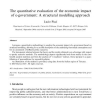Free Online Productivity Tools
i2Speak
i2Symbol
i2OCR
iTex2Img
iWeb2Print
iWeb2Shot
i2Type
iPdf2Split
iPdf2Merge
i2Bopomofo
i2Arabic
i2Style
i2Image
i2PDF
iLatex2Rtf
Sci2ools
IEPOL
2006
2006
The quantitative evaluation of the economic impact of e-government: A structural modelling approach
I propose a quantitative methodology to analyze the economic impact of e-government based on structural modeling, allowing for a careful description of the underlying theoretical assumptions and for an assessment of different policy scenarios. The transparent relation between the theory and the results obtained is an advantage with respect to purely narrative methods. The methodology departs significantly both from studies in the costbenefit analysis tradition and from the analysis of ``e-readiness'' indexes, whose purpose is a quantification of preconditions for successful policies. An illustration of the method is provided, using data from the Italian region of Tuscany.
| Added | 12 Dec 2010 |
| Updated | 12 Dec 2010 |
| Type | Journal |
| Year | 2006 |
| Where | IEPOL |
| Authors | Lucio Picci |
Comments (0)

